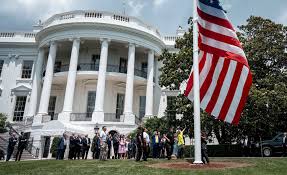A $150 billion Korean investment in the American shipbuilding industry and an additional $200 billion designated for industrial sectors are among the terms of a trade agreement announced on Friday by the United States and South Korea.
The joint declaration followed U.S. President Donald Trump and South Korean President Lee Jae-myung’s meeting in October and agreement to reduce U.S. import taxes on South Korean goods from 25% to 15%.
“Finally, the South Korea-U.S. trade, commerce, and security negotiations, which were among the biggest variables affecting our economy and security, are … concluded,” Lee stated on Friday.
“Good competition requires excellent partners, and I believe President Trump’s rational decision played a significant role in achieving meaningful agreement.”
U.S. Commerce Secretary Howard Lutnick and South Korean Industry Minister Kim Jung-kwan signed a 27-point, non-binding memorandum of understanding on strategic investments on Friday.
It outlines a timeline for projects that the U.S. president will choose after consulting with South Korea, and Seoul must send money within 45 days of the decision.
After more than three months of negotiations over Trump’s tariffs that have targeted trading partners worldwide, the trade agreement was finally announced.
The possibility of crushing taxes on important exports like semiconductors and automobiles particularly worried South Korea.
In an attempt to gain an early diplomatic victory by transforming an economic threat into a chance to improve the nation’s trade and security status, Lee assumed office five months ago with the mandate to lead the nation away from the shock of a failed martial law installation by his predecessor.
According to Lee, the deal will help South Korea “rebuild crucial industries just as the U.S. helped South Korea in the past” by forming a new cooperation with the United States on shipbuilding, artificial intelligence, and the nuclear sector.
The U.S. approved South Korea’s development of nuclear-powered submarines, according to a White House fact sheet, and will collaborate closely with Seoul to identify “avenues to source fuel.”
South Korea’s foreign exchange stability
In an attempt to maintain the won’s stability, Washington also agreed to South Korea’s request that $200 billion in cash investments be made in increments of no more than $20 billion annually.
According to the fact sheet, the nations decided that South Korea’s investments shouldn’t “give rise to market instability.”
South Korea may request an “adjustment in the amount and timing of the funding, and the United States will, in good faith, give due consideration to such a request,” it stated, if indications of instability emerge.
The United States will reduce its 25% tariffs on South Korean goods, including automobiles, to 15%.
According to a presidential adviser, semiconductors will be subject to tariff arrangements that are at least as favorable as those for Taiwan.
Former Navy officer Kim Dong-yup, who is currently a professor at Kyungnam University, stated that although Seoul had to pay significantly more for defense as a result of the nuclear energy and security pact, Lee was confronted “with an inevitable choice.”
In July, a trade agreement was first announced in concept.
















